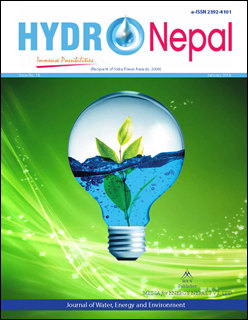Integrated Water Resource Management (IWRM): A Case Study of Durlung Watershed, Bagmati Zone, Nepal
DOI:
https://doi.org/10.3126/hn.v18i0.14645Keywords:
IWRM, Social Accounting, Community Based Water Resource Development and Management (CBWRDM), Participatory Group Formation and Mobilization Methods (PGFMM), Community Partnership, Participatory Research, Institutionalization, NepalAbstract
Water in Nepal is a key strategic natural resource, which has the potential to lead the all round development and economic growth of the country. Integrated Water Resource Management (IWRM) is a holistic management approach, integrating land water interaction, socio economic groups, upstream downstream relations, indigenous knowledge, and institutions built up, along the temporal dimensions based on an agreed set of principles. It is a bottom-up decentralized approach for the management of water resources. IWRM is a challenge to conventional practices, attitudes and professional certainties. It confronts entrenched sectoral interest & requires that the water resources are managed holistically for the benefits of all.
The broad objective of the multidisciplinary study was to assess the possibilities of Human Dimensions of water resource development and its management. Water resource accounting is done by the collection of water resources data through participatory group formation. Scientific data of hydro and metrological stations was also acquired. Hydrological modeling tools were also used. Feasibility of hydropower plant and potential of power production in the basin was readily estimated.
Total daily discharge of the Durlung Watershed was estimated on an average of 157 Million Liters. Rivers of the watershed are turbulent, unsteady & flowing with very high current, which can be utilized by local people for low cost drinking water, tourism, irrigation & hydropower generation. Micro-hydropower production possibilities in Ratan and Deuta rivers have shown multidimensional positive impacts on socio-economic development of the region. Level of community partnership in IWRM and synchronization with the local, district & national level institutional framework for Basin Management was observed to be satisfactory. Participatory research was carried to identify water resource base with school & community partnership. Community motives, their difficulties and gaps in community level organization were identified. For capabilities of community to take over the responsibilities of IWRM concept, there is a lot more need of training and capacity building for now.
HYDRO Nepal
Journal of Water Energy and Environment
Volume- 18, 2016, January
Page -47 to 54
Downloads
3072
4315
Downloads
Published
How to Cite
Issue
Section
License
The copyright of the articles and papers published is held by HYDRO Nepal Journal.
The views and interpretation in this journal are those of author(s), and HYDRO Nepal does not bear any responsibility for the views expressed by authors in the journal.




